By David Nutt
As Gov. Andrew Cuomo was preparing to sign the Climate Leadership and Community Protection Act into law, which he did July 18, researchers, policymakers and industry members gathered at Cornell’s pyrolysis facility in Leland Laboratory to explore how thermochemical conversion of biomass and waste could help New York achieve its ambitious climate goals.
“New York state has established some very aggressive goals for countering and managing climate change,” said Jan Nyrop, associate dean and the Goichman Family Director of Cornell AgriTech. “Managing this will absolutely require that we address some of the causes, as well as driving the adoption of technologies that can mitigate what has already happened.”
One potential approach is pyrolysis, the process by which biomass – organic material that comes from plants or animals – is heated without oxygen to produce solid, charcoal-like material known as biochar. Among its many possible applications, biochar can be used as fertilizer, and can sequester carbon and nitrogen, filter water and retain pollutants. Cornell opened its pyrolysis kiln in May 2018, and approximately two dozen faculty programs use biochar in one permutation or another, from building materials to agriculture, according to Johannes Lehmann, professor of soil science.
Lehmann organized the July 16 workshop in collaboration with Rochester Institute of Technology and SUNY College of Environmental Science and Forestry (ESF), and with support from the Atkinson Center for a Sustainable Future
Pyrolysis and other forms of thermochemical conversion – which include combustion and gasification – are strong candidates for supporting the “circular bioeconomy” in New York, specifically the dairy industry, according to Daryl Nydam, DVM ’97, Ph.D. ’02, professor in population medicine and diagnostic sciences.
“My personal interest in this is taking a lot of that dairy cow manure and creating alternate revenue streams and easier handling of it,” said Nydam, a faculty director for the Atkinson Center. “New York has the third-largest number of dairy cows of any state in the U.S., generating a few billion dollars for the state economy, and we’ve lived through 3 ½ years of historically low milk prices. Finding other revenue streams and coproducts will help our dairy economy not only continue to produce perfect proteins and great fats for human consumption, but also mitigate our environmental impact.”
Converting dairy material into biochar fertilizer could translate to an annual value of up to $272 million for farmers and $1.3 billion for retail operations, while reducing transportation costs by $114 million, in addition to lowering greenhouse gases worth up to $15 million at aggressive carbon trading prices, Lehmann said.
Exactly how much of a role thermochemical conversion technology can play in the climate plan is an open question. The law requires New York to reduce greenhouse gas emissions to 85% of 1990 levels by 2050, with the remaining 15% to be offset by carbon-negative projects. These offset projects must be “real, additional, verifiable, enforceable and permanent,” said Tristan Brown, associate professor at SUNY ESF. As the law is written, waste-to-energy initiatives, including incineration and pyrolysis, are not eligible as offset projects.
Policymakers were quick to point out that the current version of the law is only a framework.
“I wouldn’t read through the bill in any significant level of detail yet. Read the earnestness that the Senate, the Assembly and the Executive bring to the subject overall,” said Patrick Hooker ’84, New York deputy secretary for food and agriculture. “When you pass something the last day of session as complicated as this, you may need to go back and make corrections. So I wouldn’t worry about it. For the record, pyrolysis looks terrific.”
State Sen. Jennifer Metzger, D-42nd Dist., also emphasized that the real work was just beginning. A statewide greenhouse gas emissions inventory still needs to be conducted, and a 22-member Climate Action Council will develop a two-year scoping plan that will lay out the regulations necessary for the state to hit its aggressive climate targets.
“This is a huge, substantive piece of legislation that is really reorienting the entire state government and its business-as-usual,” she said. “From my perspective, certainly waste energy technologies in particular have to be on the table.”
Binghamton-area Assemblywoman Donna Lupardo, D-123rd Dist., acknowledged there is a significant learning curve for her and her colleagues when it comes to establishing a comprehensive, climate-friendly farming policy in the state.
“On the climate bill, for example, the senator who sponsored that bill was a former federal prosecutor, and the Assembly sponsor was a geologist,” she said. “Many of our notions of soil health really were formed by movies regarding the Dust Bowl. That is sort of the basic knowledge level … We will certainly do our best to make sure we take what we learn from you and involve it into the policy.”
The time is right, Lehmann said, to figure out how industry can move from conventional waste and manure management to a more integrated system, with products that can be shipped out of sensitive watersheds and reduced phosphorus and nitrate loads in waterways.
“This is the task for the next couple of years,” Lehmann said, “to convince policymakers and donors, together with industry and municipalities and farmers, to embark on this kind of research for New York state.”
This story originally appeared in the Cornell Chronicle.
*NYSH Editor’s Note: July 23, 2019
The story refers to biochar as a fertilizer. More accurately, biochar, when added to soil, boosts fertility.
